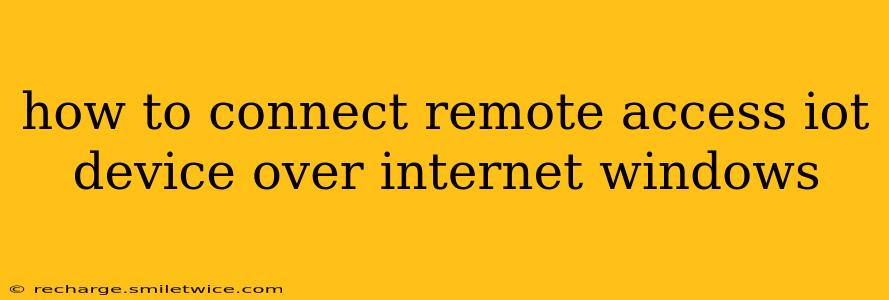Connecting your Internet of Things (IoT) device for remote access using a Windows machine involves several crucial steps. This guide outlines the process, addressing common challenges and offering solutions. We'll cover secure connection methods and best practices to protect your device and data.
What is Remote Access for IoT Devices?
Remote access for IoT devices allows you to control and monitor your device from anywhere with an internet connection. This is crucial for managing smart home appliances, industrial sensors, or any device requiring off-site management. This capability transforms the way you interact with your connected devices, enhancing convenience and control.
Choosing the Right Method: Local Network vs. Cloud Services
Two primary approaches exist for remotely accessing your IoT device:
1. Direct Connection via Your Local Network (Port Forwarding): This involves configuring your router to forward specific ports to your IoT device's internal IP address. This method offers more control, but requires technical expertise and careful security consideration. It's more suitable for experienced users.
2. Cloud-Based Services: These services act as intermediaries, providing secure remote access without the complexities of port forwarding. They handle the security aspects and often offer user-friendly interfaces. Popular options include AWS IoT Core, Azure IoT Hub, and Google Cloud IoT Core. These platforms are typically better suited for beginners and offer scalability and robust security features.
How to Connect Using Port Forwarding (Advanced Users)
This method requires familiarity with networking concepts and router settings.
1. Determine Your IoT Device's IP Address: Connect to your local network and find your device's IP address. This is usually done through your device's configuration interface or by checking your router's DHCP client list.
2. Determine the Necessary Ports: Consult your IoT device's documentation to identify the ports it uses for communication. Common ports include 80 (HTTP), 443 (HTTPS), and others depending on the device's protocol.
3. Access Your Router's Configuration: Access your router's administration interface (usually via a web browser, using an address like 192.168.1.1 or 192.168.0.1). The specific address is mentioned in your router's manual.
4. Configure Port Forwarding: Within your router's settings, look for options like "Port Forwarding," "Virtual Servers," or "NAT Forwarding." Configure rules to forward the specific ports you identified to your IoT device's IP address.
5. Test the Connection: Attempt to access your device remotely using its public IP address and the forwarded ports. This often requires a dynamic DNS service to handle changes in your public IP address.
How to Connect Using Cloud-Based Services (Beginner-Friendly)
Cloud-based services simplify the process significantly. Here's a general overview:
1. Choose a Cloud Platform: Select a cloud platform based on your requirements, budget, and experience level. Consider factors like scalability, security features, and ease of use.
2. Create an Account and Provision Resources: Create an account with your chosen platform and provision the necessary resources, such as an IoT Hub or Core.
3. Configure Your IoT Device: Configure your IoT device to connect to the chosen cloud platform. This usually involves setting up authentication credentials and communication protocols (like MQTT or AMQP).
4. Access Your Device Remotely: Use the cloud platform's provided tools or SDKs to remotely monitor and control your IoT device. The platform handles the security and networking complexities.
Security Considerations for Remote Access
1. Strong Passwords and Authentication: Use strong, unique passwords for both your IoT device and your cloud platform account. Implement multi-factor authentication (MFA) whenever possible.
2. Secure Protocols: Use secure communication protocols like HTTPS and TLS to encrypt data transmitted between your device and the internet.
3. Regular Software Updates: Keep your IoT device's firmware and the cloud platform software up-to-date to patch security vulnerabilities.
4. Firewall Configuration: Configure firewalls (both on your router and on your device) to restrict access to only necessary ports and IP addresses.
5. Monitoring and Logging: Monitor your IoT device's activity and review logs regularly to detect any suspicious behavior.
Troubleshooting Common Issues
- Unable to connect: Double-check your network configuration, port forwarding rules, and device settings. Ensure that your firewall is not blocking the connection.
- Slow connection speeds: Optimize your network settings, consider using a faster internet connection, and identify network bottlenecks.
- Security concerns: Implement strong security measures, regularly update software, and monitor your device's activity.
This guide provides a comprehensive overview. Remember to consult the specific documentation for your IoT device and chosen cloud platform for detailed instructions and best practices. Always prioritize security to protect your device and data from unauthorized access.
